Physical Address
304 North Cardinal St.
Dorchester Center, MA 02124
Even with the widespread availability of cross-sectional imaging studies, abdominal radiography remains a common imaging test in modern radiology practice. Although computed tomography (CT), magnetic resonance imaging (MRI), and ultrasound provide more information about acute abdominal conditions, abdominal radiographs (previously known as abdominal plain films before the advent of digital radiography) have the advantages of relatively low cost and ease of acquisition and can be readily performed on acutely ill or debilitated patients, so they remain a valuable study. This chapter focuses on abnormalities of gas and soft tissues that can be detected on abdominal radiographs.
The intestinal tract in adults usually contains less than 200 mL of gas. Intestinal gas has three sources—swallowed air, bacterial production, and diffusion from the blood. Supine abdominal radiographs may show gas accumulating in anteriorly placed bowel, including the antrum and body of the stomach and transverse or sigmoid colon. Gas may also be present in the small bowel or remaining colon, particularly the rectum. The gas-filled ascending and descending colon are usually located in the lateral margins of the peritoneal cavity abutting the flank stripes, the sigmoid colon in the lower abdomen, and the rectum in the lower pelvis extending inferiorly to the pubic symphysis. In contrast, gas-filled small bowel loops tend to occupy the central portion of the abdomen.
Apart from location, bowel caliber and intestinal folds are also important for differentiating colon from the small intestine. In general, the colon has a larger caliber than the small bowel (i.e., colonic diameter is normally up to 5 cm, whereas small bowel diameter is only up to 3 cm). Haustral folds in the colon are normally 2 to 3 mm in width and occur at intervals of 1 cm, whereas the circular small bowel folds (also known as plicae circulares ) are 1 to 2 mm in width and occur at intervals of only 1 mm. Thus, small bowel folds are narrower and more closely spaced than colonic haustra.
Intestinal gas is a natural contrast agent for the interpretation of abdominal radiographs. For example, a long, narrowed segment of air-filled stomach may indicate an infiltrating process such as linitis plastica. Gastric ulcers and masses are also occasionally visible ( Fig. 2.1A ). In the colon, gas may outline a narrowed lumen from ulcerative or granulomatous colitis, thickened haustral folds from ischemia ( Fig. 2.1B ), or even a polypoid or annular carcinoma (see Fig. 2.4A ).
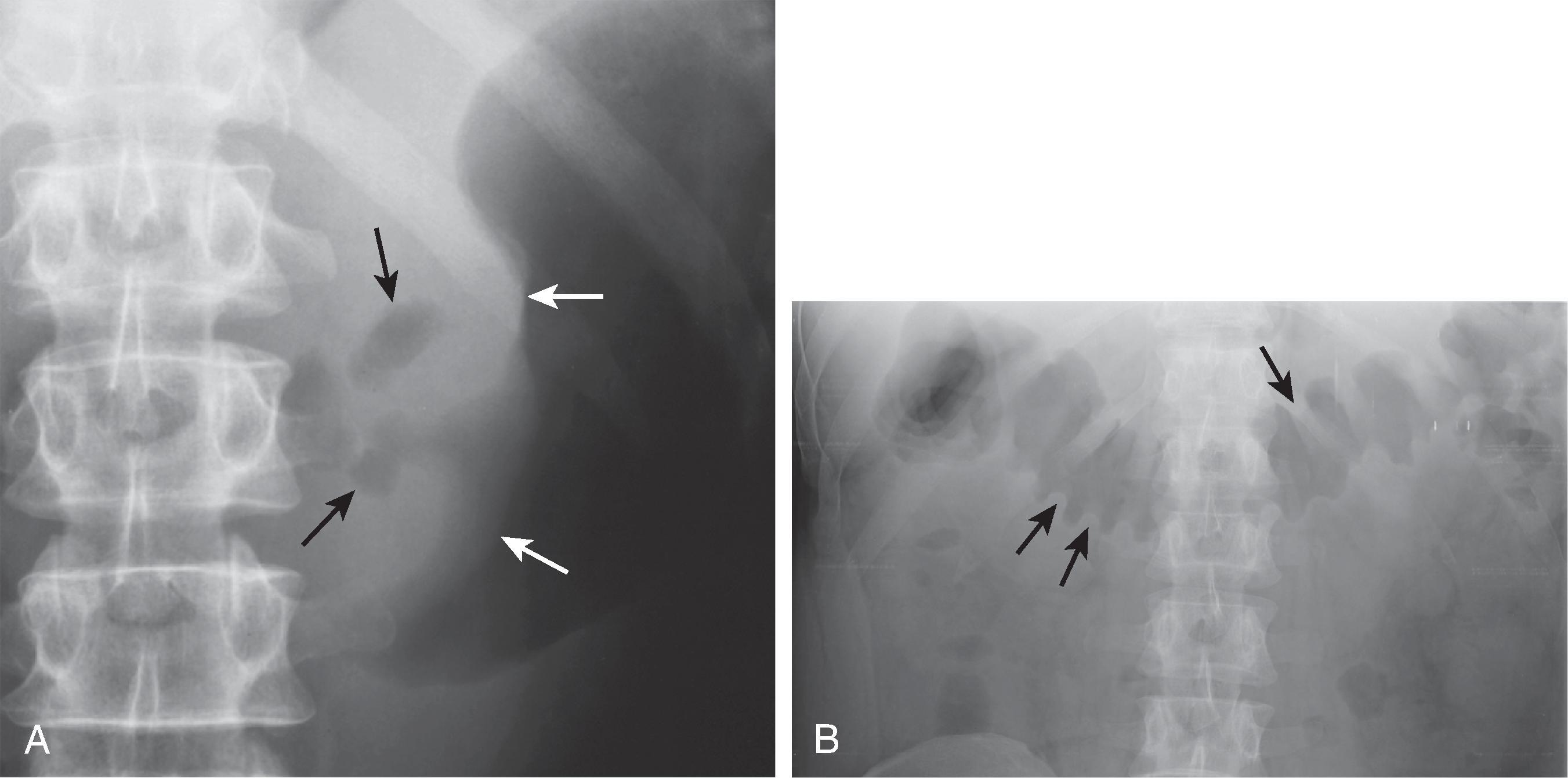
Gastric outlet obstruction may be manifested on abdominal radiographs by a dilated stomach containing air, fluid, and/or debris. A dilated, air-filled stomach is usually recognized without difficulty because of its characteristic shape and location associated with inferior displacement of the transverse colon. However, a small amount of air is almost always present in the stomach, so an upright radiograph of the chest or abdomen often shows an air-fluid level in the gastric lumen.
The distal gastric antrum and pyloric region are the usual sites of gastric outlet obstruction, most commonly resulting from acute edema and spasm associated with a distal ulcer or chronic antral scarring from a previous ulcer. Other causes of gastric outlet obstruction include an infiltrating antral carcinoma and, less commonly, scarring from granulomatous disease, radiation, or caustic ingestion.
The stomach may also be dilated because of gastroparesis or gastric atony in the absence of gastric outlet obstruction. The most common cause is diabetes (i.e., diabetic gastroparesis), but other causes include narcotic agents, hypokalemia, uremia, porphyria, lead poisoning, and previous truncal vagotomy. Pancreatitis or gastritis may also result in reflex gastric atony, and general anesthesia may occasionally cause marked gastric distention.
The term adynamic ileus (or paralytic ileus ) refers to dilated bowel in the absence of mechanical obstruction. A more specific term, postoperative ileus, is reserved for patients with recent abdominal surgery. All these terms refer to a state of decreased or absent intestinal peristalsis, causing swallowed air and fluid to accumulate in dilated bowel. An adynamic ileus is typically manifested on abdominal radiographs by dilated small bowel and colon, with multiple air-fluid levels on upright or horizontal beam decubitus views, so the presence of dilated colon enables differentiation from mechanical small bowel obstruction, in which only the small bowel is affected (see later, “Small Bowel Obstruction”). Sometimes, however, an adynamic ileus is confined to the small bowel, mimicking the findings of small bowel obstruction ( Fig. 2.2 ); therefore, the absence of colonic distention in no way excludes this condition. Other patients may have an adynamic ileus that is confined to the colon. In such cases, supine and upright abdominal radiographs typically reveal diffusely dilated colon and rectum with multiple air-fluid levels, whereas colonic obstruction is usually associated with a paucity of colonic gas distal to the site of obstruction. An adynamic ileus may result from many causes, including recent abdominal surgery, electrolyte imbalances, sepsis, generalized peritonitis, blunt abdominal trauma, and infiltration of the mesentery by tumor.
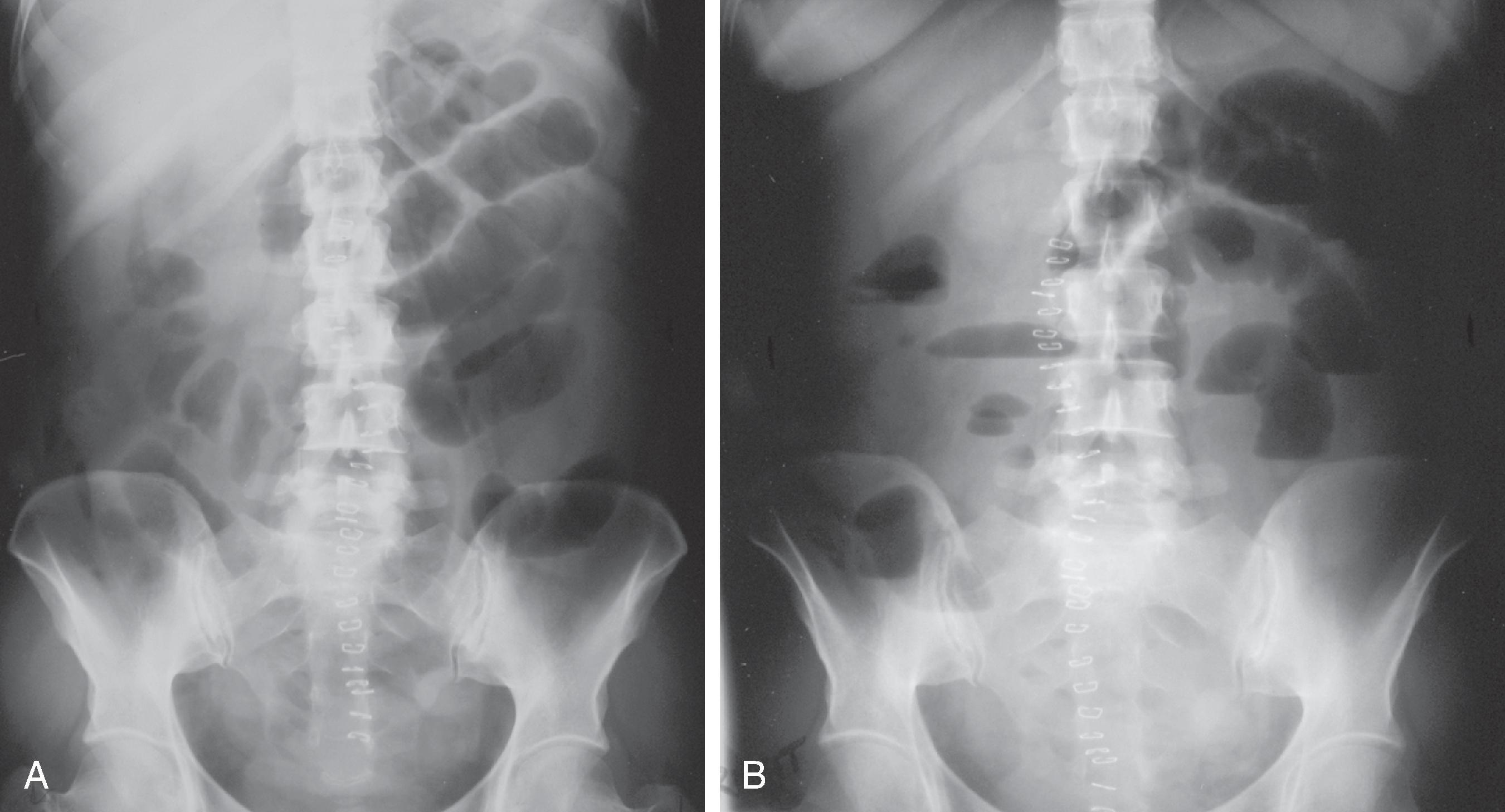
Other patients may have a localized ileus (i.e., a sentinel ileus ) involving several loops of the small bowel or colon. This type of ileus usually results from acute inflammatory conditions in adjacent regions of the abdomen, including the right lower quadrant in appendicitis, left lower quadrant in diverticulitis, and right upper quadrant in cholecystitis.
Acute colonic pseudo-obstruction (also known as Ogilvie’s syndrome ) was first described in 1948 by Ogilvie who postulated that progressive colonic dilation is caused by interruption of sympathetic innervation with unopposed parasympathetic innervation of the colon. The most common clinical presentation is acute abdominal distention, usually occurring within10 days of the onset of the precipitating pathologic process. Intra-abdominal inflammation, alcoholism, cardiac disease, burns, retroperitoneal disease, trauma, and pregnancy with spontaneous delivery or cesarean section have been described as causes of Ogilvie’s syndrome. ,
Abdominal radiographs may reveal marked colonic distention, typically confined to the cecum and the ascending and transverse colon. Occasionally, however, gas may extend as far distally as the sigmoid colon. The underlying clinical condition and rapid onset of colonic distention usually suggest the diagnosis of colonic pseudo-obstruction, but CT or a limited single-contrast enema may be required to rule out obstructing lesions.
Prediction of impending cecal perforation, as judged by cecal diameter, is unreliable because the risk of cecal perforation depends not only on the degree of distention but also on the duration. As a result, the risk is considerably less in patients with long-standing cecal distention than in those with an acute increase in cecal caliber. Although some authors have indicated that a cecal diameter of 9 to 12 cm suggests impending perforation, cecal diameters of 15 to 20 cm are commonly observed in patients who recover spontaneously from Ogilvie’s syndrome.
Intravenous (IV) neostigmine is sometimes used for the initial treatment of Ogilvie’s syndrome. Prolonged cecal distention should prompt colonoscopic or surgical decompression. The presence of intramural gas in the region of the dilated cecum should strongly suggest infarction and impending perforation.
Small bowel obstruction is often difficult to diagnose on abdominal radiographs, with false-positive and false-negative rates as high as 20%. The diagnostic sensitivity can be increased by obtaining serial abdominal radiographs to show an evolving obstructive pattern.
When the small bowel is completely obstructed, accumulation of swallowed air and intestinal secretions causes proximal dilation of the bowel, while intestinal peristalsis progressively eliminates bowel contents distal to the obstruction. As a result, this condition is typically characterized on supine abdominal radiographs by dilated, gas-filled small bowel loops larger than 3 cm in diameter, with little or no gas in the small bowel or colon distal to the obstruction ( Fig. 2.3A ). Upright or decubitus abdominal radiographs typically reveal multiple air-fluid levels in the dilated small bowel because of accumulation of gas and fluid in these loops ( Fig. 2.3B ).
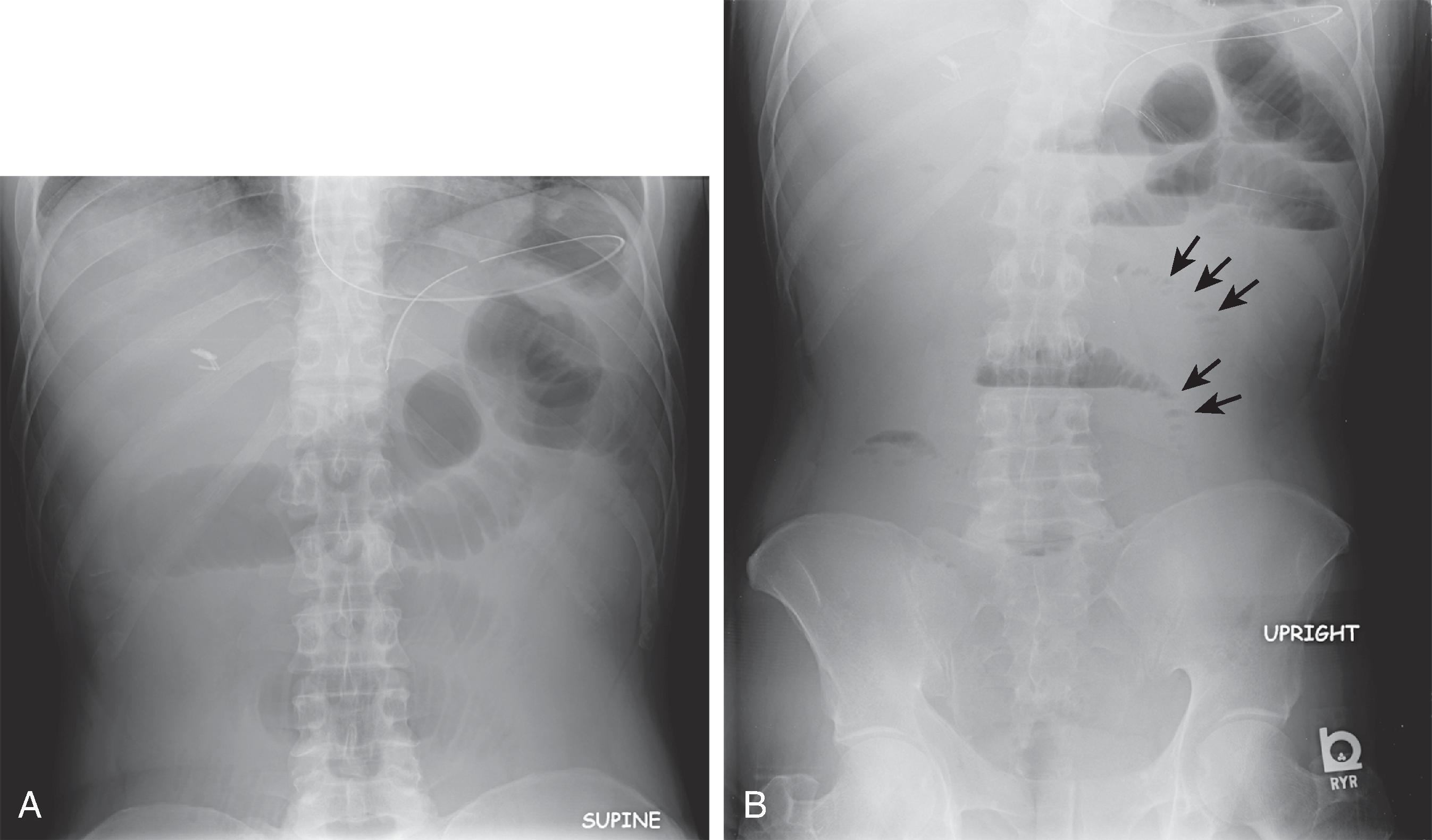
As small bowel obstruction progresses, gas-filled small bowel loops above the obstruction become more dilated and tend to have a horizontal orientation in the central abdomen, producing a classic stepladder appearance. However, the amount of gaseous distention depends not only on the degree of obstruction but also on its duration, the amount of air swallowing or emesis, and the use of nasogastric suction for decompression. In some patients who swallow little air, supine abdominal radiographs may be unrevealing, whereas upright or decubitus radiographs will show multiple air-fluid levels in small bowel loops above the obstruction. In other patients, small amounts of gas trapped between small bowel folds on upright or decubitus radiographs may appear as tiny bubbles of gas lined up along the nondependent bowel surface, also known as the string of pearls sign (see Fig. 2.3B ). Finally, when patients swallow little or no air, abdominal radiographs may reveal multiple tubular soft tissue densities representing fluid-filled loops of small bowel, and a paucity of bowel gas distal to the obstruction, producing a so-called gasless abdomen .
Most small bowel obstructions are caused by postoperative adhesions, which may occur as early as 1 week after surgery, but usually develop months to years later. In the absence of a surgical history, an obstructing hernia should be suspected; 95% are external hernias (inguinal, femoral, umbilical, or incisional). The presence of air-filled bowel loops below either pubic ramus should suggest an obstructing inguinal hernia. Other, less common causes of small bowel obstruction include small bowel tumors, ectopic gallstones, acute appendicitis, and, occasionally, intestinal parasites or bezoars.
If small bowel obstruction is suspected on abdominal radiographs, further evaluation with CT is usually indicated. Barium studies of the small bowel may also be helpful when abdominal radiographs suggest low-grade or partial small bowel obstruction.
More than 50% of colonic obstructions are caused by annular carcinomas of the colon. The most common site is the sigmoid colon, where the bowel has a narrower caliber. Conversely, carcinomas of the cecum and ascending colon are less likely to cause obstruction because of the wider caliber of the right side of the colon.
Colonic obstruction is typically manifested on abdominal radiographs by dilated, gas-filled loops of colon proximal to the obstruction, with a paucity gas in the distal colon and rectum ( Fig. 2.4A ). The absence of rectal gas is a particularly important feature for differentiating colonic obstruction from colonic ileus. If prone, decubitus, or left lateral-vertical beam views of the pelvis show free passage of gas into the rectum, distal colonic obstruction is very unlikely. Air-fluid levels in the dilated colon are often seen on upright or decubitus views ( Fig. 2.4B ).
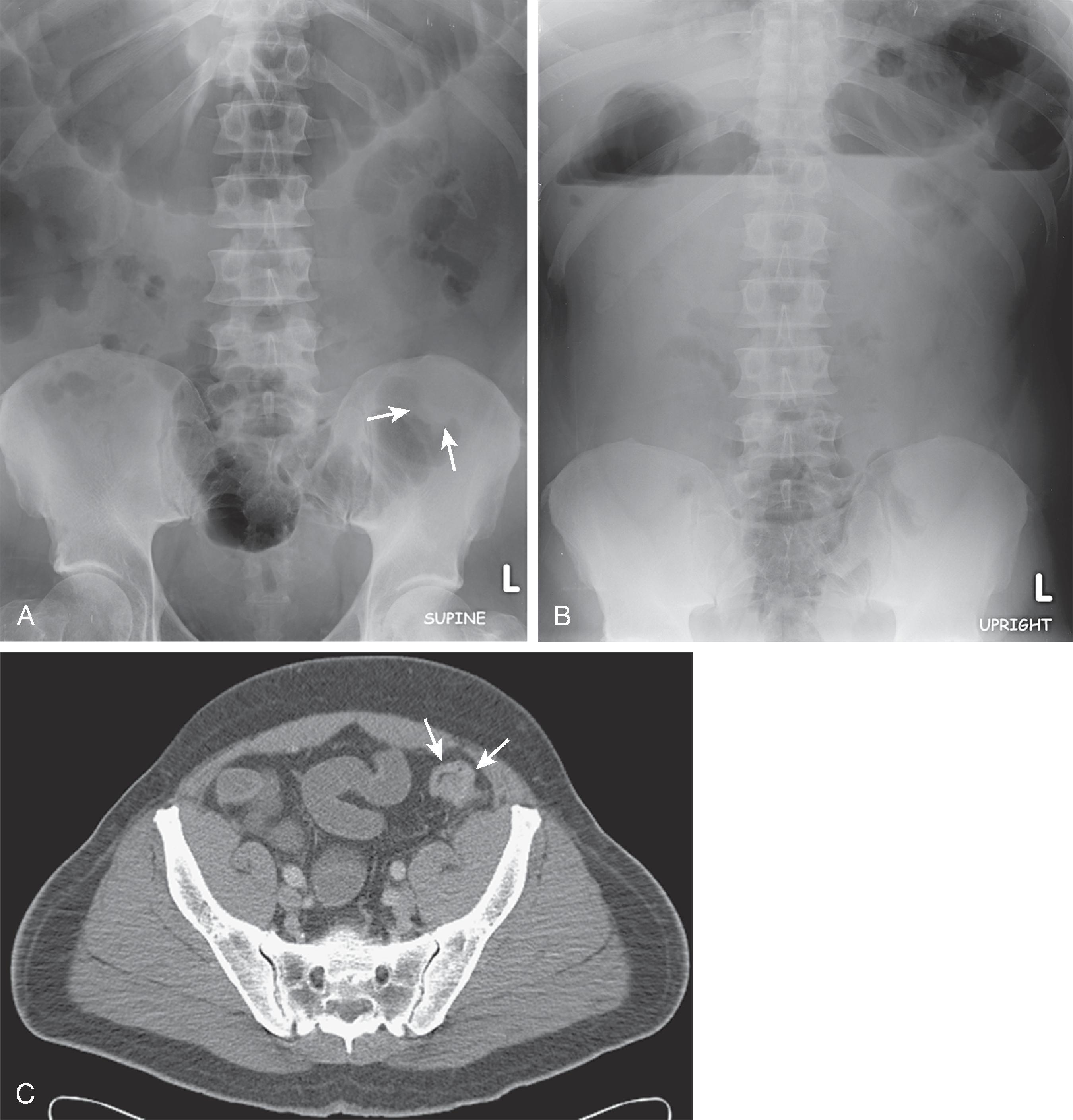
Abdominal CT or a single-contrast enema may be performed to confirm the presence of obstruction and determine its underlying cause ( Fig. 2.4C ). In patients with a competent ileocecal valve, there may be marked colonic (especially cecal) dilation, with little or no gas in the small bowel. As the cecal diameter increases, the risk of perforation also increases. In various series, colonic perforation has been reported in as many as 7% of all colonic obstructions and 2% of obstructing carcinomas. , Such perforations usually result from progressive ischemia of the dilated colon or cecum proximal to the obstruction.
In some patients with colonic obstruction, an incompetent ileocecal valve allows colonic gas to reflux into the small bowel, decompressing the colon, so the radiographic findings can mimic those of small bowel obstruction. Nevertheless, this distinction has important implications, as orally administered barium can inspissate above an unsuspected colonic obstruction. Abdominal CT or a single-contrast enema should therefore be considered in patients with apparent obstruction of the distal small bowel on abdominal radiographs (especially an older patient with no prior abdominal surgery) to rule out an underlying colonic carcinoma as the cause.
A closed loop obstruction refers to a segment of bowel that is obstructed at two points. Closed loop obstructions usually involve the small bowel and are caused by adhesions, internal hernias, or volvulus. The findings on abdominal radiographs are often nonspecific. Occasionally, there may be a disproportionately dilated, gas-filled loop of small bowel that has the appearance of a coffee bean. Vascular compromise may lead to edema of the affected loop with thickened or effaced folds in this loop. If the obstructed segment fills with fluid, a rounded soft tissue density produces a pseudotumor appearance. CT may be helpful for further evaluation of these patients.
Any segment of intestine with a mesenteric attachment has the potential to undergo a volvulus. Some patients may have intermittent intestinal twists with recurrent episodes of pain or emesis. If the twist is greater than 360 degrees, however, it is unlikely to resolve spontaneously. The risk of vascular compromise in the twisted segment is even more life-threatening than the obstructive effect of the volvulus. Severe vascular compromise may result in necrosis and perforation of the bowel, causing sepsis and death.
The term sigmoid volvulus refers to twisting of an elongated sigmoid colon on its mesentery. Sigmoid volvulus constitutes 60% to 75% of all cases of colonic volvulus and 1% to 2% of all intestinal obstructions in the United States. , The incidence of sigmoid volvulus is extremely high in some parts of South America and Africa, presumably because of a high-fiber diet and the resultant large, bulky stools, producing a chronically dilated, elongated sigmoid colon that predisposes patients to this type of volvulus. In the United States, sigmoid volvulus tends to occur in older men and in residents of nursing homes and mental hospitals, in whom chronic constipation causes gaseous and fecal distention of the sigmoid colon and subsequent stretching of the sigmoid mesocolon.
Patients with sigmoid volvulus typically present with abdominal pain and distention from colonic obstruction. Obstipation and vomiting are less common. The symptoms are usually acute but sometimes have a gradual onset.
Findings on abdominal radiographs are diagnostic of sigmoid volvulus in about 75% of patients. The classic appearance consists of a massively dilated sigmoid loop that has an inverted U configuration and extends superiorly into the left upper quadrant beneath the left diaphragm, with air-fluid levels in both its ascending and descending limbs. However, the dilated sigmoid loop can be in the midline or even extend into the right upper quadrant ( Fig. 2.5 ). Although the more proximal colon may also be dilated, disproportionate sigmoid dilation and extension of the dilated loop superiorly above the transverse colon are important features for differentiating sigmoid volvulus from simple colonic obstruction.
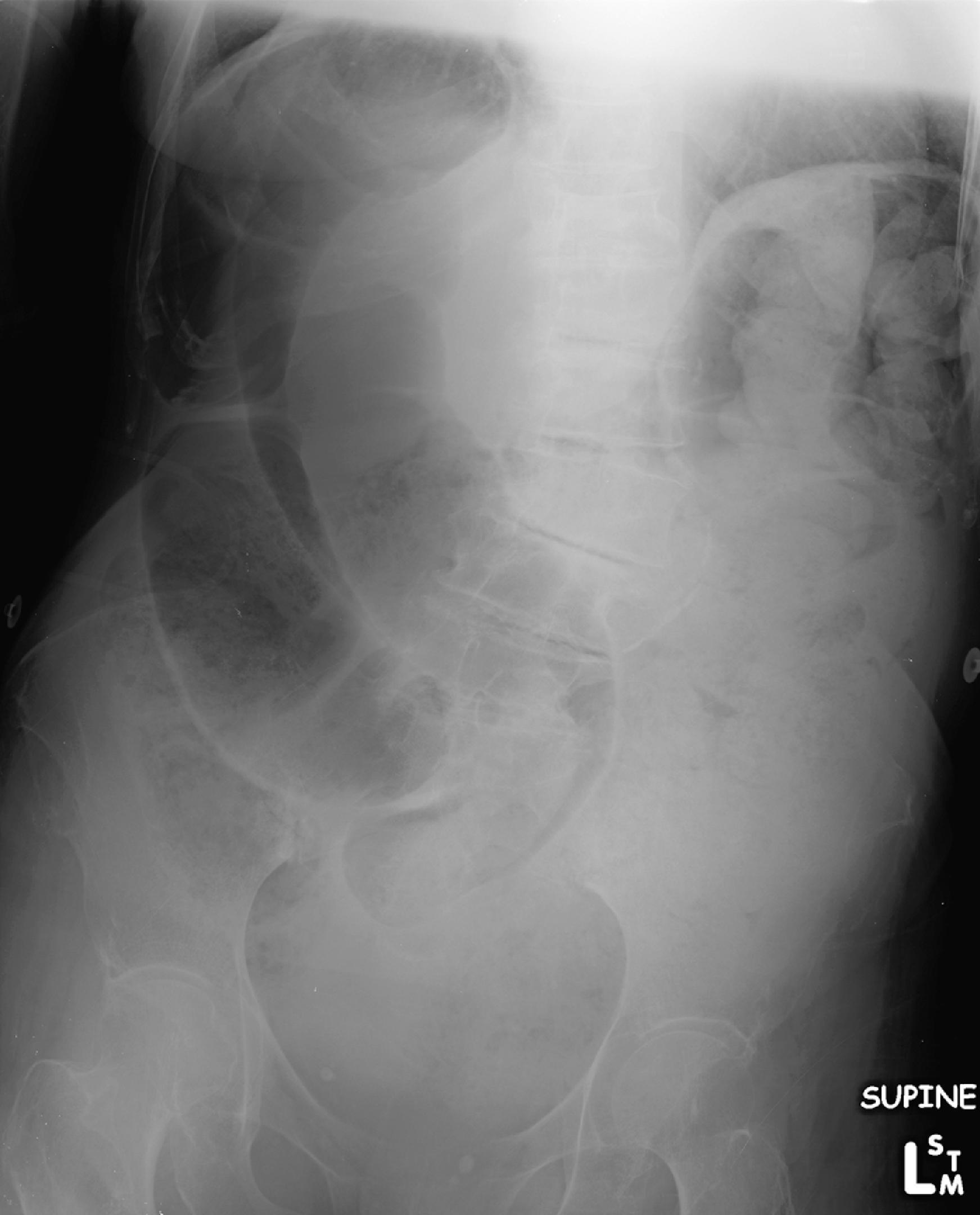
The diagnosis of sigmoid volvulus may be confirmed by abdominal CT or a single-contrast enema showing high-grade obstruction with smooth, tapered, beaklike narrowing at the site of the twist or volvulus.
Some patients with sigmoid volvulus can be successfully treated by placement of a rectal tube for decompression of the dilated sigmoid loop. Patients who have clinical or radiographic signs of ischemia, persistent sigmoid dilation despite rectal tube placement, or recurrent episodes of sigmoid volvulus may require surgical resection of the sigmoid colon for definitive treatment.
The term cecal volvulus refers to a condition caused by a rotational twist of the right colon on its long axis, so the cecum flips into the midabdomen or left upper quadrant. Cecal volvulus can occur only when the right colon is incompletely fused to the posterior parietal peritoneum, an embryologic variant present in 10% to 37% of adults. Such individuals have a persistent mesentery on the ascending colon, which is therefore mobile and can twist on its mesentery, producing a volvulus. Nevertheless, the vast majority of patients with this embryologic variant never develop cecal volvulus. Furthermore, the term “cecal volvulus” is a misnomer because the twist occurs distal to the ileocecal valve. Cecal volvulus is less common than sigmoid volvulus, accounting for about one-third of all cases of colonic volvulus.
The characteristic findings of cecal volvulus, which are present on abdominal radiographs in about 75% of patients, consist of a markedly dilated, gas-filled cecum containing a single air-fluid level in an ectopic location ( Fig. 2.6 ), usually with the cecal apex in the left upper quadrant. The medially placed ileocecal valve may produce a soft tissue indentation, so the gas-filled cecum has the appearance of a coffee bean or kidney bean. In most patients, little gas is seen more distally in the colon. The diagnosis may be confirmed by abdominal CT or a single-contrast enema showing a beaklike configuration at the point of the volvulus in the proximal ascending colon.
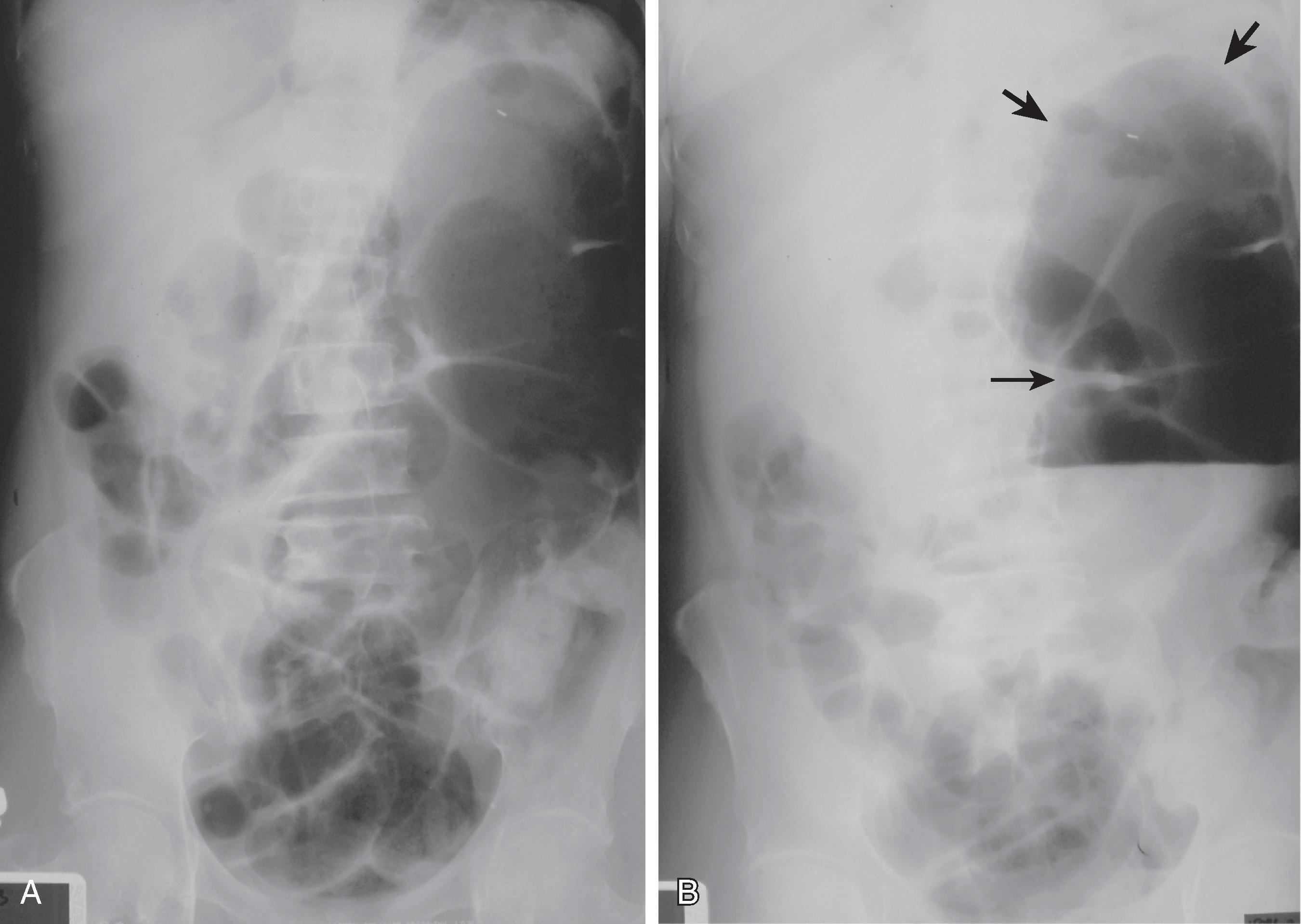
In 1938, Weinstein described a condition known as cecal bascule , which involved folding of the right colon without twisting, so the cecum occupied a position in the midabdomen. This entity also requires a persistent mesentery on the ascending colon. Others have challenged the concept of cecal bascule, arguing that these patients have a focal adynamic ileus of the cecum. Regardless of the pathophysiology, these patients are also at risk for cecal perforation. A dilated, ectopically located cecum may therefore be a source of abdominal symptoms and potential cecal perforation.
Cecal volvulus should be differentiated from a prolonged colonic ileus in bedridden patients with a persistent mesentery on the ascending colon because the anteriorly located cecum in these patients may become disproportionately dilated, mimicking the appearance of a cecal volvulus. This has been described as cecal pseudovolvulus . Unlike patients with true cecal volvulus, however, this condition is associated with diffuse colonic distention, so it is usually possible to differentiate these conditions on abdominal radiographs.
Volvulus of the transverse colon is an uncommon condition, accounting for only about 4% of all cases of colonic volvulus in the United States. In such patients, elongation of the transverse mesocolon and close approximation of the hepatic and splenic flexures may allow the transverse colon to twist on its mesenteric attachment. Failure of normal fixation of the mesentery may lead to increased mobility of the ascending colon and hepatic flexure, predisposing these patients to volvulus of the transverse colon. Mortality rates as high as 33% have been reported in these individuals.
Abdominal radiographs are usually not helpful for patients with volvulus of the transverse colon and may erroneously suggest sigmoid volvulus. A single-contrast enema may confirm the diagnosis if it shows typical beaking and obstruction at the level of the transverse colon. Two separate air-fluid levels sometimes can be seen in the dilated transverse colon, a finding that helps differentiate volvulus of the transverse colon from cecal volvulus.
Splenic flexure volvulus is the least common type of colonic volvulus. Postoperative adhesions, chronic constipation, and congenital or surgical absence of the normal peritoneal attachments of the splenic flexure predispose patients to this uncommon condition. , Abdominal radiographs may reveal a dilated, featureless, air-filled loop of bowel in the left upper quadrant separate from the stomach, with air-fluid levels in the transverse colon and cecum. When a splenic flexure volvulus is suspected, a single-contrast enema may be performed for a more definitive diagnosis.
Become a Clinical Tree membership for Full access and enjoy Unlimited articles
If you are a member. Log in here